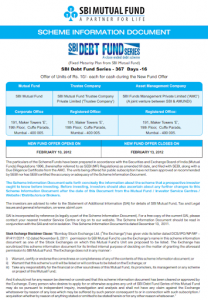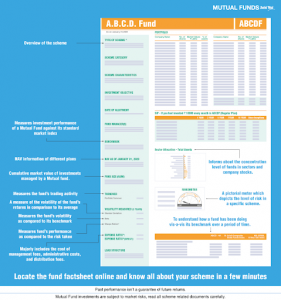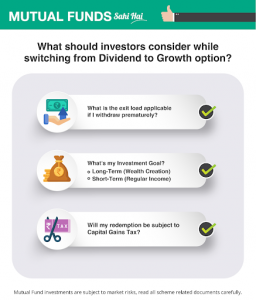Important Terms to Know About Funds (Part 2)

In the last chapter, Shalini has shared some amazing terminologies that are most commonly used in mutual funds. Raju was ecstatic learning them, and we hope you are too. Well, hold your horses, there are a few more mutual funds jargons Shalini wants to share with you. So, without any further ado, let’s get started.
Introduction
Everyone wants to grow their money, but some are less-risk takers, while others are high-risk takers. Mutual funds have options for every category – from less risky to medium to high. Before investing in mutual funds, investors should have a set goal and objective. That’s not it. There are a lot of mutual fund terms every investor should know about. Because investment jargons are a bit intimidating if not understood. This especially happens with non-financial investors, or people new to investing. However, irrespective of the type of investor, it’s pivotal to have knowledge of the subject prior to investing in mutual funds. So, here is the list of mutual fund terms that every investor must keep a note of.
Scheme Information Document (SID)
Every investor must give a glance, and study through the mutual fund documents before investing in any fund or a scheme. SID is one of the mutual fund documents given by fund houses when you want to invest in a mutual fund. This document contains all important information with respect to the scheme. The main goal of SID is to keep you educated and literate about the fund or scheme they are planning to invest in.

Some of the details include in the Scheme Information Document are investment scheme objective, entry load, exit load, the experience of the fund manager, past performance of the fund, asset under management, asset allocation, expense ratio, the benchmark of the fund, tax implications, minimum subscription, and many relevant details in respect to the mutual fund scheme. The format of SID is designed and structured by SEBI. Plus, the content formulated by SEBI should be aligned in the document as per the given format. You can find the SID document to read on any AMC website.
Scheme Additional Information (SAI):
This is another important information document that every investor must-read. Also known as the mutual fund prospectus, Scheme Additional Information or SAI contains extra information about the fund or the scheme that you are planning to stock your money into. Also called as Part B prospectus, this document tells you about the modifications made in the scheme with respect to the operations, gives you an overview update about the financials, legal details, sponsors information, AMC, about the constitution of the mutual fund, unitholder rights, and general information about taxes and other assets. Investors can avail of this document at AMCs without paying any fee. In fact, upon the investor’s request, the AMCs provide the SAI document for free to all the investors.
Key Information Memorandum (KIM):
This document is a summarized version of SID. Key Information Memorandum (KIM) is brief and precise to the point. The document covers all the key information about the mutual fund scheme. Key Information Memorandum document is given along with the scheme details.
Mutual Fund Fact Sheet:
You hear a lot of people saying that mutual funds are a risky investment. That’s because of a lack of awareness about the list of products or funds available in the market, and the obliviousness of how it works. Now, whether you are an apprehensive investor or a regular investor, it’s pivotal to know about the scheme. Like, their performance, benchmark, fund manager, and many other relevant details. Mutual Fund Fact Sheet provides all the aforementioned information, followed by key facts about the fund. Knowing inside-out about the fund prior to investing gives precision and clarity to the investors of what they are dealing with.

Here are some of the details you can find in the factsheet: Fund Manager name, fees, the risk factor involved, fund’s start date, the benchmark of the fund, exit load, assets under management (AUM) at the end of the month, and basic investment required. The Securities Exchange Board Of India or SEBI directed the mutual fund houses to send the fund factsheets to all the investors on a monthly basis.
Open-Ended Schemes:
This is a mutual fund scheme classified based on structure. As the name speaks volumes, in this scheme, investors can buy and sell the units at Net Asset Value (NAV), which keeps on changing every day. Also, these open-ended funds are not traded on the stock exchange. The best part of these funds is they are highly liquid in nature, meaning, you can redeem your units at the existing NAV. Plus, this scheme doesn’t have a predetermined maturity period or a lock-in period. Another benefit for choosing an open-ended scheme is that, unlike the close-ended funds, here you can choose between options like SIP, or SWP, or STP.
Furthermore, investors can check out the past performance of the fund before investing their money. This helps you in making better investment decisions. As far as tax payments on mutual funds are concerned, it depends on the type of fund i.e. equity or debt. For equity investments, if the investor holds for a year or less, they are entitled to pay 15% tax, and 10% for more than a year. For debt investments, if it’s short-term, the tax rate depends on the slab rate, and 20% after indexation for above 3 years. This scheme would be the best fit for salary drawing employees.
Close Ended Schemes:
It’s a subscription-based model, where investors can avail the units only during the launch. The close-ended funds operate via NFO or New Fund Offer. Here, investors have the leeway to buy or redeem the unit only in between the start and close period of the NFO. All the units in the close-ended funds are traded on the stock exchange. Unlike open-ended funds, there’s a fixed maturity period for close-ended funds.
In this scheme, investors can’t quit before the maturity period, but if they want to, they can trade their units at the current price on the exchange. Moreover, the pricing in close-ended funds changes every day. Whilst the scheme lacks flexibility and liquidity, it allows investors to trade at real-time prices i.e. at the NAV on a particular day. The tax rates are similar to open-ended schemes. The only exception with this scheme is that investors have to invest in a lump sum because there’s no SIP option here.
Fixed Maturity Plans (FMP):
Nowadays, Fixed Maturity Plans have become a popular investment avenue for investors. Also known as close-ended funds, here, the fund manager invests in debt securities for a set period of time. The maturity for the Fixed Maturity Plans ranges from one month to five years. As they are debt-oriented, investors can’t trade them like open-ended funds, however, they dispense stable yet indicative returns. Some of the benefits of putting your money in FMPs are capital protection, nominal interest rate, less cost, and lower tax. Unlike debt funds, the fund manager doesn’t buy and sell units incessantly, instead, holds them for a period, resulting in less expense ratio. If you are looking for a better alternative to fixed deposits, FMPs can fulfill your needs. This plan suits investors who are willing to take the risk of NAV variations. In juxtaposed to equities, investment in FMPs is less risky and more profitable.
Dividend Option:
Investors investing in mutual funds have a choice on how to utilize their return on investment. Investors who receive income from the mutual funds can either reinvest that gain in the fund and withdraw at the end of the maturity period or can enjoy the benefit of monthly dividends through the dividend option. Here, the fund house distributes the surplus to the investors monthly or bi-annually, or annually in the form of dividends. If the fund house distributes the dividend, the NAV decreases by the surplus distributed.
Say, you have invested in a mutual fund at a NAV of Rs 25, after a period, the NAV rises to Rs 30. The fund house then announces a dividend of Rs 3, and eventually, the NAV nosedives to Rs 27. Hence, the investor will receive a dividend of Rs 3 per unit. If you observe cautiously, the NAV value plunges in the dividend option as the extra returns are deducted from the NAV to pay dividends to the investors. If you are looking for a regular inflow of income, dividend options are one option to go with.

Growth Option:
Mutual fund investors always get perplexed when it comes to choosing between growth option and dividend option. As you have already seen the dividend option, here, you’ll get to know the growth option. In this option, the investors won’t receive dividends in case of profits, instead, the surplus cash earned is reinvested into the fund. Here, there won’t be any regular income like the dividend option. If the investor is looking to grow their money for the long term, the growth option is the better one to choose. To help you understand how the growth option works, here’s a small example.
If Raju bought 30 units at a NAV of 50, after a period, the NAV increased to 70. Now, Raju can sell his units at 70. The old value = 30 units × old NAV 50 = Rs 1500. And the new value = 30 units ×new NAV 70 = Rs 2100. So, Raju earned the following profit – Rs 2100 – Rs 1500 = Rs 600. The best option for investing in a growth option is the compounding effect of reinvesting the extra gains, which you don’t find in the dividend option.
Expense Ratio:
Before investing in mutual funds, a lot of investors look into the following metrics: Fund’s historical performance, fund manager’s experience, underlying assets, and returns generated by the fund over the years. The important thing most investors miss out looking for is the hidden charges like operating costs, advertising fees, exit and entry load, management fees, and a few other expenses. It’s cumulatively called the expense ratio.
The aforementioned charges are levied by the fund manager for managing the mutual fund scheme. It’s like the annual maintenance fee for taking holistic care of the fund in growing or generating returns to the investors. For passively managed funds like ETFs, index funds, and open-ended funds, the expense ratio is relatively less compared to actively managed funds like close-ended funds, debt funds, equity funds, and hybrid funds.
The lesser the expense ratio, the better would be your returns. For actively managed funds, the good expense ratio is anywhere between 0.5 percent to 0.75 percent from the investors’ standpoint. If the expense ratio is beyond 1.5 percent, it’s considerably higher.
In nutshell
- Mutual Fund Fact sheet provides information like the performance, benchmark, fund manager of the particular fund.
- The expense ratio provides information on charges like operating costs, advertising fees, exit and entry loads, management fees, and a few other expenses.
- Fixed Maturity Plans or close-ended funds are debt funds that cannot be openly traded but provide stable returns.
- Dividend Funds are useful for those who wish to receive regular income in the form of dividends. However, this will impact the overall NAV of the fund.
- In the Growth Option, the investor receives a dividend but instead of getting regular income, the amount is reinvested to grow the fund further.


How Would You Rate This Chapter?
Next
Comments (0)